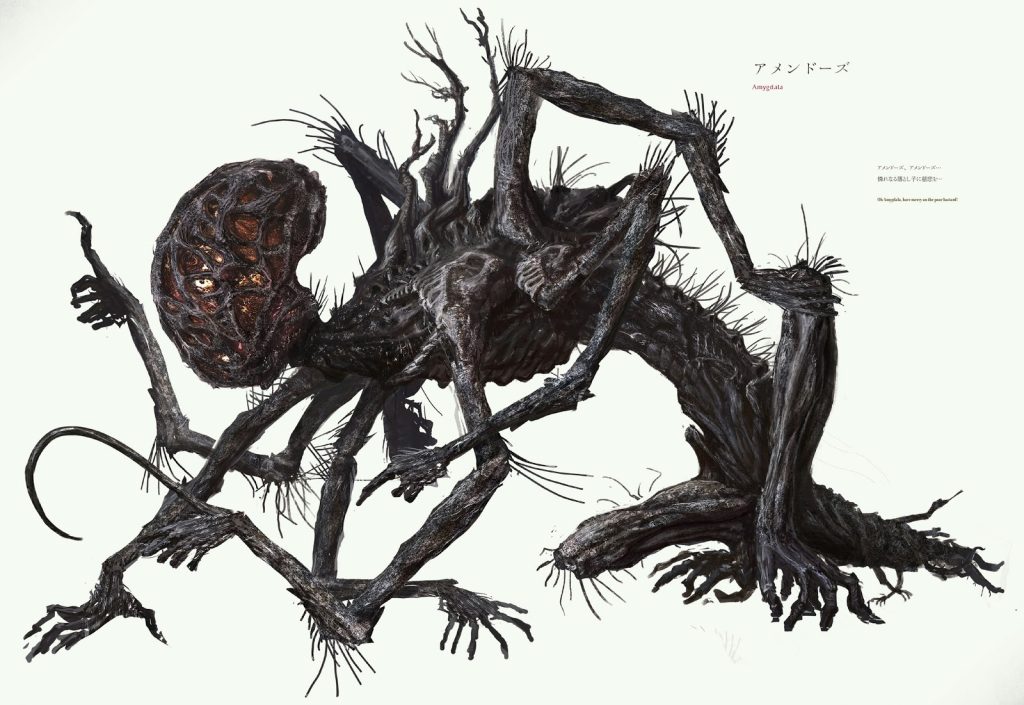In this fifth installment of How Games Tell Tales, I will discuss how games can tell stories without actually telling a story at all. I will explore how a game such as Bloodborne can create a narrative that players collectively imagine through exploration, vague hints, and atmosphere.
So far in this series, we have explored ways in which games tell stories, but those stories were always told quite directly. But what if a game opts to do something entirely different? What if players are incentivized to figure out a game’s story by themselves?
This is, at least partly, the case for plenty of Fromsoftware’s games, which only partly tell their stories, or only offer slight hints as to what happened in their game worlds. In this post, I will explore how this works through the frame of Bloodborne. I will show how this game has players imagine a narrative, and that most of the story a player directly engages with will be within the game’s atmosphere instead.
The Cosmic Horror: A Story You Cannot Comprehend
The world of Bloodborne is heavily inspired by H.P. Lovecraft’s cosmic horror. It draws heavily from his work, with the game’s DLC going into a fishing village, which almost directly comes from one of the man’s books. Bloodborne goes as far in its inspiration as calling its own cosmic creatures ´The Great Ones´ – whereas Lovecraft referred to them as ´Great Old Ones´. The search for knowledge, and the negative burden that such knowledge has within the stories of H.P. Lovecraft is reflected within Bloodborne’s mechanics and story, as the player can become more ‘frenzied’ the more ‘insight’ they gain. Crucially, the cosmic horror present in Lovecraft’s work is one that can never be truly understood.
Within Bloodborne, these cosmic horrors are the aforementioned Great Ones, otherworldly beings that control events of the story, from the rise of a blood moon, to the birth of demonic children, and a plague that turns men into beasts. Why these creatures do all this, is unclear. This is the horror of it, the player hunts down beasts and great ones, and traverses into the realm of dreams and nightmares, but it is unclear what game they are a part of, or whose pawn they are and why.

So far it sounds like the game has a story, right? Well, it only has a handful of cutscenes, none of which really explains what is going on. The dialogue with other characters is rather vague, mentioning having to hunt beasts, or not to trust the healing church. Players can connect some of these dots themselves, within the tale. For example, the following note can be found in a burned-down old centre of a city:
“The red moon hangs low, and beasts rule the streets. Are we left no other choice, than to burn it all to cinders?”
Another note can be found later in the game, which says:
“When the red moon hangs low, the line between man and beast is blurred. And when the Great Ones descend, a womb will be blessed with child.”
This answers the connection between a red moon and beasts, but adds more questions concerning the Great Ones, and an apparent pregnancy. When the player later encounters a pregnant ancient queen, that provides some connection, but does not fully answer the questions one might have.
And that’s the crux of it: the story is a puzzle you seemingly can solve, but you will never have all the pieces. As such, you find yourself wanting to uncover the impossible. So, how would you even come to understand the story?

Collectively Imagining A Narrative
Well, that becomes a community effort. Within the Bloodborne Discord server, a place with over 25 thousand members, there is a separate lore channel, devoted entirely to answering all the questions about what players know from descriptions, notes, and dialogue, and what that means about events preceding the game, or what can happen next.
Essentially, the story design trick is a very neat one: players can choose to engage with a deeper understanding of the story, by opting to read item descriptions, to read notes around the world, to actually pay attention to the scarce dialogues the game provides. And then, one can take all this information, and discuss it with others who play the game.
This form of storytelling is unique to the video game medium, of course. You cannot present a movie in which a part of the story is entirely optional to view, and you (probably) would not make a book with hidden pages. But for a game, you can turn optional exploration into storytelling! And that is what these games seem to do.
But then, questions still remain, and the story seems to be unresolved. While events are guessed at, and attempts at timelines are constructed, and players reach a consensus on things that very likely happened….a large portion of this is imagined by players. And players can also disagree with one another! Almost none of the guesswork is directly confirmed in the source material, there are mostly hints and ideas, words and concepts that connect between descriptions, but none of it is clear. The developers did not really get involved with the lore after the game’s launch either, leaving the community to make their own educated guesses at what is going on.
So then, if the story seems impossible to comprehend….is it even telling one?
Atmosphere As The True Story
Some players in the community, such as myself, have argued that the game’s actual story is not the descriptions, it is not the notes or the dialogue, but it is in the atmosphere of the game’s areas. An old abandoned castle, filled with ghosts. An immortal queen of this same castle, guarded by someone who died a long time ago. A dream the player can walk around in, a city, burned down, taken over by beasts who used to be human. Alien creatures, staring at you from a distance. Hidden rituals, a red blood moon. It all invokes….something. It’s vague, it’s scary, its intentions are unclear. And that is kind of the point, I would argue. The player character does not understand what is happening any better than you do. They are but a toy in the hands of universal powers that they cannot hope to understand. To try to truly understand what is going on is a fool’s errand, one that will only cause more frenzy than it might be worth.

And this atmosphere, this veil of fog that is laid over the story of Bloodborne, that is its story to me. Bloodborne’s story is that it has no clear story to tell, and that it is whatever the player, or a group of players, imagine it to be.
